Efficient Activation of Coal Fly Ash for Silica and Alumina Leaches and the Dependence of Pb(II) Removal Capacity on the Crystallization Conditions of Al-MCM-41
Abstract
:1. Introduction
2. Results and Discussion
2.1. CFA Activation
2.1.1. Raw CFA Analysis
2.1.2. Activation Optimization of CFA
2.2. Relevance of Crystallization Parameters and the Al-MCM-41 Structure
2.3. Relevance of Crystallization Parameters and Pb(II) Removal Capacity
3. Experiments
3.1. Materials
3.2. CFA Activation
3.3. Al-MCM-41 Synthesis
3.4. Functionalization
3.5. Characterization
3.6. Pb(II) Removal
3.7. Adsorbent Regeneration
4. Conclusions
Author Contributions
Funding
Institutional Review Board Statement
Informed Consent Statement
Data Availability Statement
Acknowledgments
Conflicts of Interest
References
- Culita, D.C.; Simonescu, C.M.; Patescu, R.-E.; Dragne, M.; Stanica, N.; Oprea, O. o-Vanillin functionalized mesoporous silica—Coated magnetite nanoparticles for efficient removal of Pb(II) from water. J. Solid State Chem. 2016, 238, 311–320. [Google Scholar] [CrossRef]
- Guo, Y.; Liu, D.; Zhao, Y.; Gong, B.; Guo, Y.; Huang, W. Synthesis of chitosan-functionalized MCM-41-A and its performance in Pb(II) removal from synthetic water. J. Taiwan Inst. Chem. Eng. 2017, 71, 537–545. [Google Scholar] [CrossRef]
- Wamba, A.G.N.; Kofa, G.P.; Koungou, S.N.; Thue, P.S.; Lima, E.C.; dos Reis, G.S.; Kayem, J.G. Grafting of Amine functional group on silicate based material as adsorbent for water purification: A short review. J. Environ. Chem. Eng. 2018, 6, 3192–3203. [Google Scholar] [CrossRef]
- Fu, F.; Wang, Q. Removal of heavy metal ions from wastewaters: A review. J. Environ. Manag. 2011, 92, 407–418. [Google Scholar] [CrossRef] [PubMed]
- Koshy, N.; Singh, D.N. Fly ash zeolites for water treatment applications. J. Environ. Chem. Eng. 2016, 4, 1460–1472. [Google Scholar] [CrossRef]
- Beck, J.S.; Vartuli, J.C.; Roth, W.J.; Leonowicz, M.E.; Kresge, C.T.; Schmitt, K.D.; Chu, C.T.W.; Olson, D.H.; Sheppard, E.W.; McCullen, S.B.; et al. A new family of mesoporous molecular sieves prepared with liquid crystal templates. J. Am. Chem. Soc. 1992, 114, 10834–10843. [Google Scholar] [CrossRef]
- Kresge, C.T.; Leonowicz, M.E.; Roth, W.J.; Vartuli, J.C.; Beck, J.S. Ordered mesoporous molecular sieves synthesized by a liquid-crystal template mechanism. Nature 1992, 359, 710–712. [Google Scholar] [CrossRef]
- Selvam, P.; Bhatia, S.K.; Sonwane, C.G. Recent advances in processing and characterization of periodic mesoporous MCM-41 silicate molecular sieves. Ind. Eng. Chem. Res. 2001, 40, 3237–3261. [Google Scholar] [CrossRef]
- Idris, S.A.; Davidson, C.M.; McManamon, C.; Morris, M.A.; Anderson, P.; Gibson, L.T. Large pore diameter MCM-41 and its application for lead removal from aqueous media. J. Hazard. Mater. 2011, 185, 898–904. [Google Scholar] [CrossRef]
- Thakur, A.K.; Nisola, G.M.; Limjuco, L.A.; Parohinog, K.J.; Torrejos, R.E.C.; Shahi, V.K.; Chung, W.-J. Polyethylenimine-modified mesoporous silica adsorbent for simultaneous removal of Cd(II) and Ni(II) from aqueous solution. J. Ind. Eng. Chem. 2017, 49, 133–144. [Google Scholar] [CrossRef]
- Li, W.; Fu, F. Incorporating MnFe2O4 onto the thiol-functionalized MCM-41 for effective capturing of Sb(III) in aqueous media. Microporous Mesoporous Mater. 2020, 298, 110060. [Google Scholar] [CrossRef]
- Deng, A.; Yuan, J.; Qi, C.; Gao, Y. Hollow SiO2 microspheres with thiol-rich surfaces: The scalable templated fabrication and their application for toxic metal ions adsorption. Mater. Chem. Phys. 2020, 243, 122625. [Google Scholar] [CrossRef]
- Benhamou, A.; Baudu, M.; Derriche, Z.; Basly, J.P. Aqueous heavy metals removal on amine-functionalized Si-MCM-41 and Si-MCM-48. J. Hazard. Mater. 2009, 171, 1001–1008. [Google Scholar] [CrossRef]
- Lim, M.H.; Stein, A. Comparative Studies of Grafting and Direct Syntheses of Inorganic−Organic Hybrid Mesoporous Materials. Chem. Mater. 1999, 11, 3285–3295. [Google Scholar] [CrossRef]
- Manu, V.; Mody, H.M.; Bajaj, H.C. Effect of Thermal Treatment of Silica Gels on Their Amino Functionalization and Subsequent Adsorption Properties for Cu2+ from Aqueous Solution of Copper Sulfate. Ind. Eng. Chem. Res. 2010, 49, 8184–8191. [Google Scholar] [CrossRef]
- Liou, T.-H. A green route to preparation of MCM-41 silicas with well-ordered mesostructure controlled in acidic and alkaline environments. Chem. Eng. J. 2011, 171, 1458–1468. [Google Scholar] [CrossRef]
- Deekamwong, K.; Kaiyasuan, C.; Jitcharoen, J.; Wittayakun, J. Influence of gel composition and microwave-assisted hydrothermal time in MCM-41 synthesis. Mater. Chem. Phys. 2017, 201, 384–390. [Google Scholar] [CrossRef]
- Cheng, C.-F.; Zhou, W.; Ho Park, D.; Klinowski, J.; Hargreaves, M.; Gladden, L.F. Controlling the channel diameter of the mesoporous molecular sieve MCM-41. J. Chem. Soc. Faraday Trans. 1997, 93, 359–363. [Google Scholar] [CrossRef]
- McManamon, C.; Burke, A.M.; Holmes, J.D.; Morris, M.A. Amine-functionalised SBA-15 of tailored pore size for heavy metal adsorption. J. Colloid Interface Sci. 2012, 369, 330–337. [Google Scholar] [CrossRef]
- Da’na, E. Adsorption of heavy metals on functionalized-mesoporous silica: A review. Microporous Mesoporous Mater. 2017, 247, 145–157. [Google Scholar] [CrossRef]
- Glotov, A.; Vutolkina, A.; Pimerzin, A.; Nedolivko, V.; Zasypalov, G.; Stytsenko, V.; Karakhanov, E.; Vinokurov, V. Ruthenium Catalysts Templated on Mesoporous MCM-41 Type Silica and Natural Clay Nanotubes for Hydrogenation of Benzene to Cyclohexane. Catalysts 2020, 10, 537. [Google Scholar] [CrossRef]
- Dong, C.; Deng, X.; Guo, X.; Wang, B.; Ye, X.; Fan, J.; Zhu, C.; Fan, F.; Qing, B. Synthesis of potassium metal ferrocyanide/Al-MCM-41 with fast and selective adsorption of cesium. Colloids Surf. A Physicochem. Eng. Asp. 2021, 613, 126107. [Google Scholar] [CrossRef]
- Subsadsana, M.; Kham-or, P.; Sangdara, P.; Suwannasom, P.; Ruangviriyachai, C. Synthesis and catalytic performance of bimetallic NiMo- and NiW-ZSM-5/MCM-41 composites for production of liquid biofuels. J. Fuel Chem. Technol. 2017, 45, 805–816. [Google Scholar] [CrossRef]
- Sohrabnezhad, S.; Daraie Mooshangaie, S. In situ fabrication of n-type Ag/AgBr nanoparticles in MCM-41 with rice husk (RH/MCM-41) composite for the removal of Eriochrome Black-T. Mater. Sci. Eng. B 2019, 240, 16–22. [Google Scholar] [CrossRef]
- Liu, J.; Wei, X.; Xue, J.; Su, H. Preparation and adsorption properties of mesoporous material PS-MCM-41 with low-silicon content peanut shell ash as silicon source. Mater. Chem. Phys. 2020, 241, 122355. [Google Scholar] [CrossRef]
- Ma, Y.; Chen, H.; Shi, Y.; Yuan, S. Low cost synthesis of mesoporous molecular sieve MCM-41 from wheat straw ash using CTAB as surfactant. Mater. Res. Bull. 2016, 77, 258–264. [Google Scholar] [CrossRef]
- Li, C.-C.; Qiao, X.-C.; Yu, J.-G. Large surface area MCM-41 prepared from acid leaching residue of coal gasification slag. Mater. Lett. 2016, 167, 246–249. [Google Scholar] [CrossRef]
- Cheng, S.-Y.; Liu, Y.-Z.; Qi, G.-S. Experimental study of CO2 capture enhanced by coal fly ash-synthesized NH2-MCM-41 coupled with high gravity technology. Chem. Eng. J. 2020, 400, 125946. [Google Scholar] [CrossRef]
- Yao, Z.T.; Ji, X.S.; Sarker, P.K.; Tang, J.H.; Ge, L.Q.; Xia, M.S.; Xi, Y.Q. A comprehensive review on the applications of coal fly ash. Earth-Sci. Rev. 2015, 141, 105–121. [Google Scholar] [CrossRef] [Green Version]
- Zanoletti, A.; Federici, S.; Borgese, L.; Bergese, P.; Ferroni, M.; Depero, L.E.; Bontempi, E. Embodied energy as key parameter for sustainable materials selection: The case of reusing coal fly ash for removing anionic surfactants. J. Clean. Prod. 2017, 141, 230–236. [Google Scholar] [CrossRef]
- Kumar, P.; Mal, N.; Oumi, Y.; Yamana, K.; Sano, T. Mesoporous materials prepared using coal fly ash as the silicon and aluminium source. J. Mater. Chem. 2001, 11, 3285–3290. [Google Scholar] [CrossRef]
- Höller, H.; Wirsching, U. Zeolite formation from fly-ash. Fortschr. Mineral. 1985, 63, 21–43. [Google Scholar]
- Shigemoto, N.; Hayashi, H.; Miyaura, K. Selective formation of Na-X zeolite from coal fly ash by fusion with sodium hydroxide prior to hydrothermal reaction. J. Mater. Sci. 1993, 28, 4781–4786. [Google Scholar] [CrossRef]
- Wu, X.W.; Ma, H.W.; Zhang, L.T.; Wang, F.J. Adsorption properties and mechanism of mesoporous adsorbents prepared with fly ash for removal of Cu(II) in aqueous solution. Appl. Surf. Sci. 2012, 261, 902–907. [Google Scholar] [CrossRef]
- Majchrzak-Kucęba, I.; Nowak, W. Characterization of MCM-41 mesoporous materials derived from polish fly ashes. Int. J. Miner. Process. 2011, 101, 100–111. [Google Scholar] [CrossRef]
- Hui, K.S.; Chao, C.Y. Synthesis of MCM-41 from coal fly ash by a green approach: Influence of synthesis pH. J. Hazard. Mater. 2006, 137, 1135–1148. [Google Scholar] [CrossRef]
- Zhou, C.; Gao, Q.; Luo, W.; Zhou, Q.; Wang, H.; Yan, C.; Duan, P. Preparation, characterization and adsorption evaluation of spherical mesoporous Al-MCM-41 from coal fly ash. J. Taiwan Inst. Chem. Eng. 2015, 52, 147–157. [Google Scholar] [CrossRef]
- Tanaka, H.; Fujii, A.; Fujimoto, S.; Tanaka, Y. Microwave-Assisted Two-Step Process for the Synthesis of a Single-Phase Na-A Zeolite from Coal Fly Ash. Adv. Powder Technol. 2008, 19, 83–94. [Google Scholar] [CrossRef]
- Shoppert, A.A.; Loginova, I.V.; Chaikin, L.I.; Rogozhnikov, D.A. Alkali Fusion-Leaching Method For Comprehensive Processing Of Fly Ash. KnE Mater. Sci. 2017, 2. [Google Scholar] [CrossRef] [Green Version]
- Querol, X.; Moreno, N.; Umaña, J.C.; Alastuey, A.; Plana, F. Synthesis of zeolites from coal fly ash: An overview. J. Int. J. Coal Geol. 2002, 50, 413–423. [Google Scholar] [CrossRef]
- Querol, X.; Alastuey, A.; López-Soler, A.A.; Plana, F.; Andrés, J.M.; Juan, R.; Ferrer, A.P.; Ruiz, C.R. A Fast Method for Recycling Fly Ash: Microwave-Assisted Zeolite Synthesis. J. Environ. Sci. 1997, 31, 2527–2533. [Google Scholar] [CrossRef]
- Kim, J.K.; Lee, H.D. Effects of step change of heating source on synthesis of zeolite 4A from coal fly ash. J. Ind. Eng. Chem. 2009, 15, 736–742. [Google Scholar] [CrossRef]
- Halina, M.; Ramesh, S.; Yarmo, M.A.; Kamarudin, R.A. Non-hydrothermal synthesis of mesoporous materials using sodium silicate from coal fly ash. Mater. Chem. Phys. 2007, 101, 344–351. [Google Scholar] [CrossRef]
- Chang, H.L.; Chun, C.M.; Aksay, I.A.; Shih, W.H. Conversion of fly ash into mesoporous aluminosilicate. Ind. Eng. Chem. Res. 1999, 38, 973–977. [Google Scholar] [CrossRef]
- Misran, H.; Singh, R.; Begum, S.; Yarmo, M.A. Processing of mesoporous silica materials (MCM-41) from coal fly ash. J. Mater. Process. Technol. 2007, 186, 8–13. [Google Scholar] [CrossRef]
- Panek, R.; Wdowin, M.; Franus, W.; Czarna, D.; Stevens, L.A.; Deng, H.; Liu, J.; Sun, C.; Liu, H.; Snape, C.E. Fly ash-derived MCM-41 as a low-cost silica support for polyethyleneimine in post-combustion CO2 capture. J. CO2 Util. 2017, 22, 81–90. [Google Scholar] [CrossRef]
- Gomes, W.A.; Cardoso, L.A.M.; Gonzaga, A.R.E.; Aguiar, L.G.; Andrade, H.M.C. Influence of the extraction methods to remove organic templates from Al-MCM-41 molecular sieves. Mater. Chem. Phys. 2005, 93, 133–137. [Google Scholar] [CrossRef]
- Dinh Du, P.; Hieu, N.T.; To, T.C.; Bach, L.G.; Tinh, M.X.; Xuan Mau, T.; Quang Khieu, D. Aminopropyl Functionalised MCM-41: Synthesis and Application for Adsorption of Pb(II) and Cd(II). Adv. Mater. Sci. Eng. 2019, 2019, 1–15. [Google Scholar] [CrossRef] [Green Version]
- Mukherjee, S.; Samanta, A.N. Amine-impregnated MCM-41 in post-combustion CO2 capture: Synthesis, characterization, isotherm modelling. Adv. Powder Technol. 2019, 30, 3231–3240. [Google Scholar] [CrossRef]
- Wu, S.; Li, F.; Xu, R.; Wei, S.; Li, G. Synthesis of thiol-functionalized MCM-41 mesoporous silicas and its application in Cu(II), Pb(II), Ag(I), and Cr(III) removal. J. Nanopart Res. 2009, 12, 2111–2124. [Google Scholar] [CrossRef]
- Wang, Y.; Du, T.; Qiu, Z.; Song, Y.; Che, S.; Fang, X. CO2 adsorption on polyethylenimine-modified ZSM-5 zeolite synthesized from rice husk ash. Mater. Chem. Phys. 2018, 207, 105–113. [Google Scholar] [CrossRef]
- Dos Santos, T.C.; Bourrelly, S.; Llewellyn, P.L.; Carneiro, J.W.; Ronconi, C.M. Adsorption of CO2 on amine-functionalised MCM-41: Experimental and theoretical studies. Phys. Chem. Chem. Phys. 2015, 17, 11095–11102. [Google Scholar] [CrossRef] [PubMed]
- Stathi, P.; Dimos, K.; Karakassides, M.A.; Deligiannakis, Y. Mechanism of heavy metal uptake by a hybrid MCM-41 material: Surface complexation and EPR spectroscopic study. J. Colloid Interface Sci. 2010, 343, 374–380. [Google Scholar] [CrossRef] [PubMed]
- Walcarius, A.; Etienne, M.; Lebeau, B. Rate of Access to the Binding Sites in Organically Modified Silicates. 2. Ordered Mesoporous Silicas Grafted with Amine or Thiol Groups. Chem. Mater. 2003, 15, 2161–2173. [Google Scholar] [CrossRef]
- Lee, J.Y.; Chen, C.H.; Cheng, S.; Li, H.Y. Adsorption of Pb(II) and Cu(II) metal ions on functionalized large-pore mesoporous silica. Int. J. Environ. Sci. Technol. 2016, 13, 65–76. [Google Scholar] [CrossRef] [Green Version]
- Kim, Y.; Lee, B.; Yi, J. Preparation of Functionalized Mesostructured Silica Containing Magnetite (MSM) for the Removal of Copper Ions in Aqueous Solutions and Its Magnetic Separation. Sep. Sci. Technol. 2003, 38, 2533–2548. [Google Scholar] [CrossRef]
- Sugawara, R.; Nakamura, A.; Murakami, K. Synthesis of temperature-responsive magnetic mesoporous silica and temperature dependence of its physical properties. Colloids Surf. A Physicochem. Eng. Asp. 2020, 591, 124465. [Google Scholar] [CrossRef]
- Liang, X.; Xu, Y.; Sun, G.; Wang, L.; Sun, Y.; Qin, X. Preparation, characterization of thiol-functionalized silica and application for sorption of Pb2+ and Cd2+. Colloids Surf. A Physicochem. Eng. Asp. 2009, 349, 61–68. [Google Scholar] [CrossRef]
- Song, X.; Li, L.; Zhou, L.; Chen, P. Magnetic thiolated/quaternized-chitosan composites design and application for various heavy metal ions removal, including cation and anion. Chem. Eng. Res. Des. 2018, 136, 581–592. [Google Scholar] [CrossRef]
- Li, G.; Zhao, Z.; Liu, J.; Jiang, G. Effective heavy metal removal from aqueous systems by thiol functionalized magnetic mesoporous silica. J. Hazard. Mater. 2011, 192, 277–283. [Google Scholar] [CrossRef]
- Enache, D.F.; Vasile, E.; Simonescu, C.M.; Culita, D.; Vasile, E.; Oprea, O.; Pandele, A.M.; Razvan, A.; Dumitru, F.; Nechifor, G. Schiff base-functionalized mesoporous silicas (MCM-41, HMS) as Pb(ii) adsorbents. RSC Adv. 2018, 8, 176–189. [Google Scholar] [CrossRef] [Green Version]
- Raganati, F.; Alfe, M.; Gargiulo, V.; Chirone, R.; Ammendola, P. Kinetic study and breakthrough analysis of the hybrid physical/chemical CO2 adsorption/desorption behavior of a magnetite-based sorbent. Chem. Eng. J. 2019, 372, 526–535. [Google Scholar] [CrossRef]
- Lihua, L.; Li, T.; Yang, G.; Wang, Y.; Tang, A.; Ling, Y. Synthesis of thiol-functionalized mesoporous calcium silicate and its adsorption characteristics for heavy metal ions. J. Environ. Chem. Eng. 2017, 5, 6201–6215. [Google Scholar] [CrossRef]
- Liu, A.M.; Hidajat, K.; Kawi, S.; Zhao, D.Y. A new class of hybrid mesoporous materials with functionalized organic monolayers for selective adsorption of heavy metal ions. Chem. Commun. 2000, 1145–1146. [Google Scholar] [CrossRef]
- Kanani, N.; Bayat, M.; Shemirani, F.; Ghasemi, J.B.; Bahrami, Z.; Badiei, A. Synthesis of magnetically modified mesoporous nanoparticles and their application in simultaneous determination of Pb(II), Cd(II) and Cu(II). Res. Chem. Intermed. 2017, 44, 1689–1709. [Google Scholar] [CrossRef]
- Chen, L.Y.; Jaenicke, S.; Chuah, G.K. Thermal and hydrothermal stability of framework-substituted MCM-41 mesoporous materials. Microporous Mater. 1997, 12, 323–330. [Google Scholar] [CrossRef]
- Sepehrian, H.; Ahmadi, S.J.; Waqif-Husain, S.; Faghihian, H.; Alighanbari, H. Adsorption studies of heavy metal ions on mesoporous aluminosilicate, novel cation exchanger. J. Hazard. Mater. 2010, 176, 252–256. [Google Scholar] [CrossRef]
- Li, D.; Min, H.; Jiang, X.; Ran, X.; Zou, L.; Fan, J. One-pot synthesis of Aluminum-containing ordered mesoporous silica MCM-41 using coal fly ash for phosphate adsorption. J. Colloid Interface Sci. 2013, 404, 42–48. [Google Scholar] [CrossRef]
- Deekamwong, K.; Wittayakun, J. Template removal by ion-exchange extraction from siliceous MCM-41 synthesized by microwave-assisted hydrothermal method. Microporous Mesoporous Mater. 2017, 239, 54–59. [Google Scholar] [CrossRef]

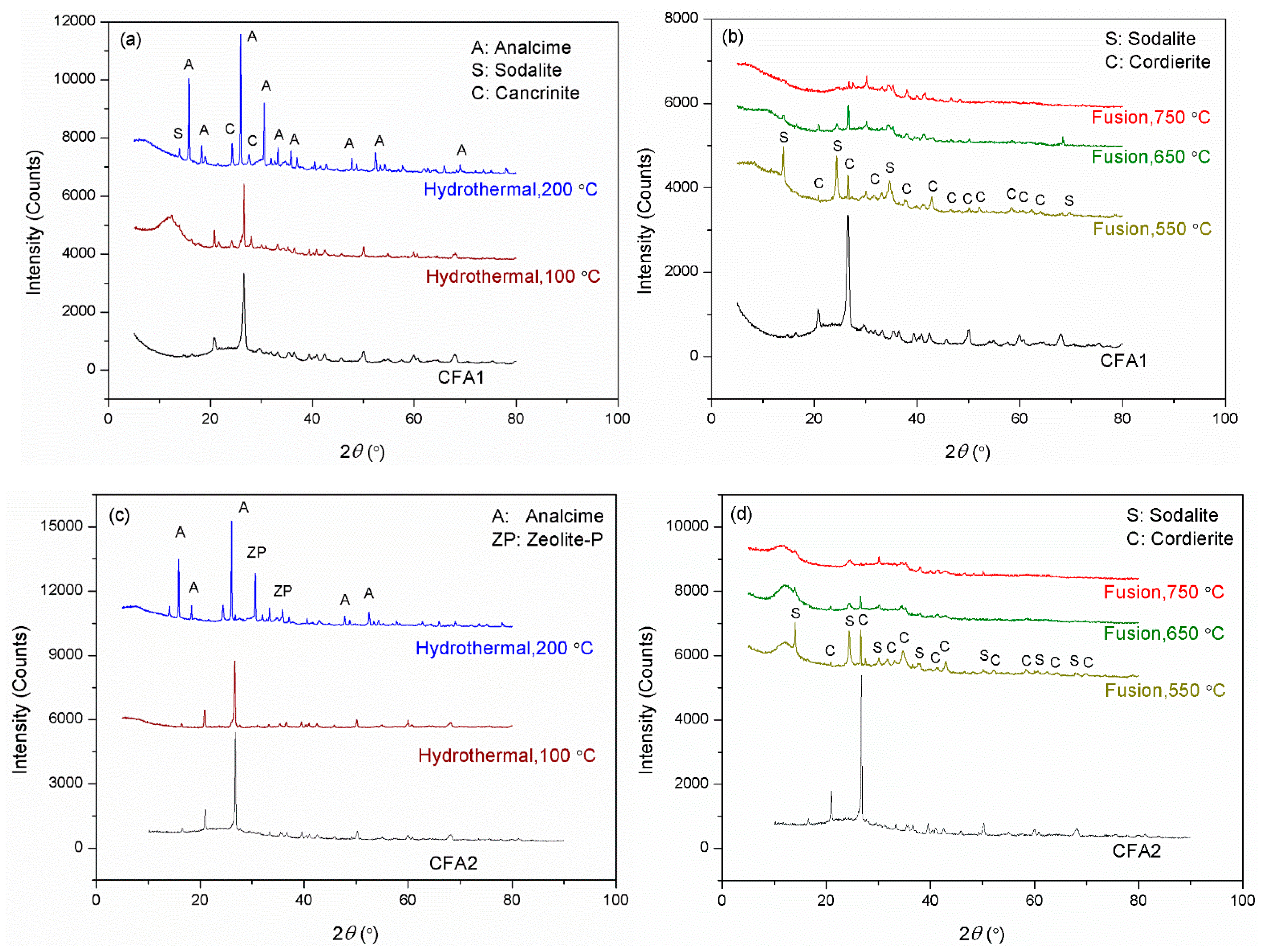
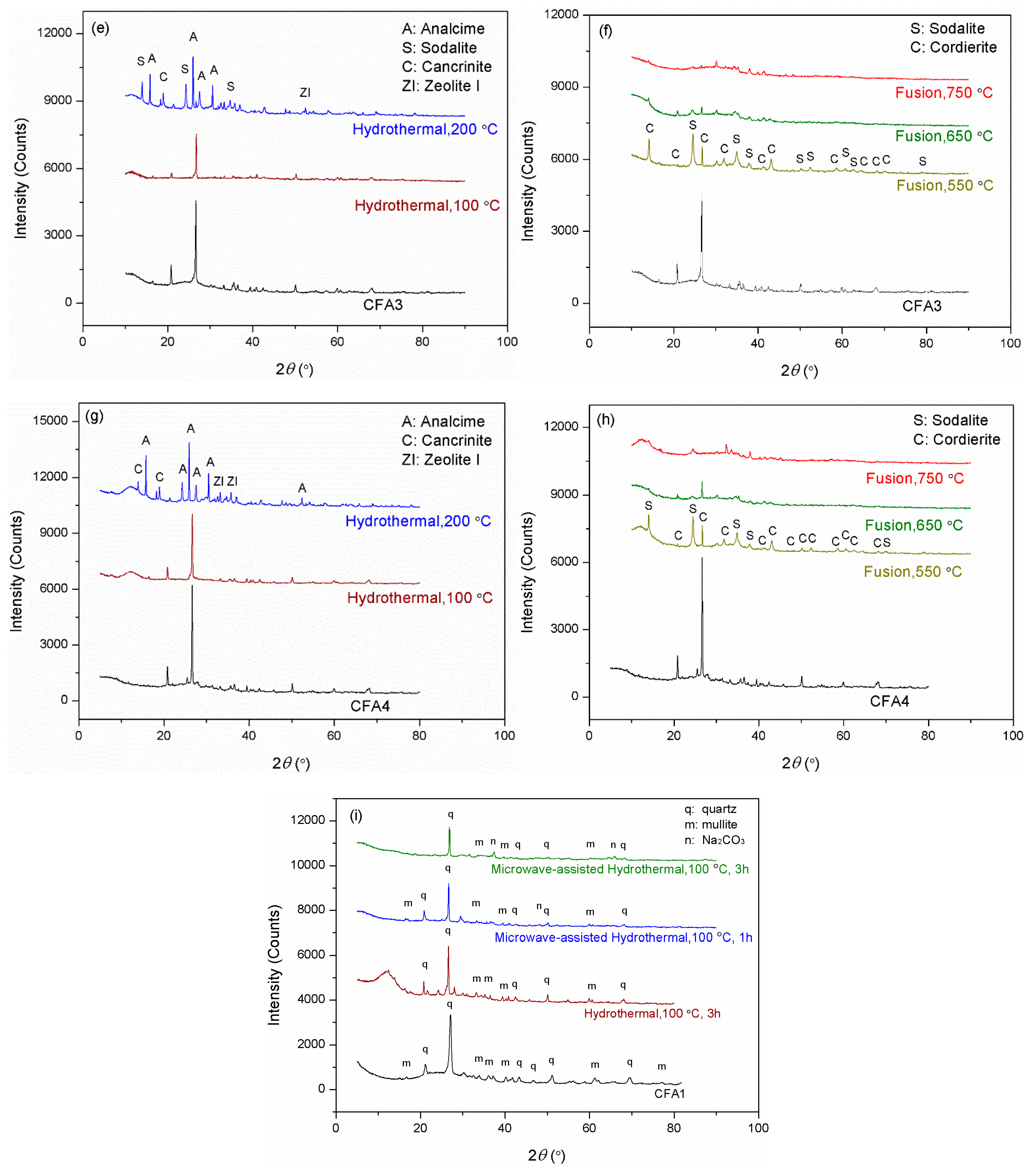
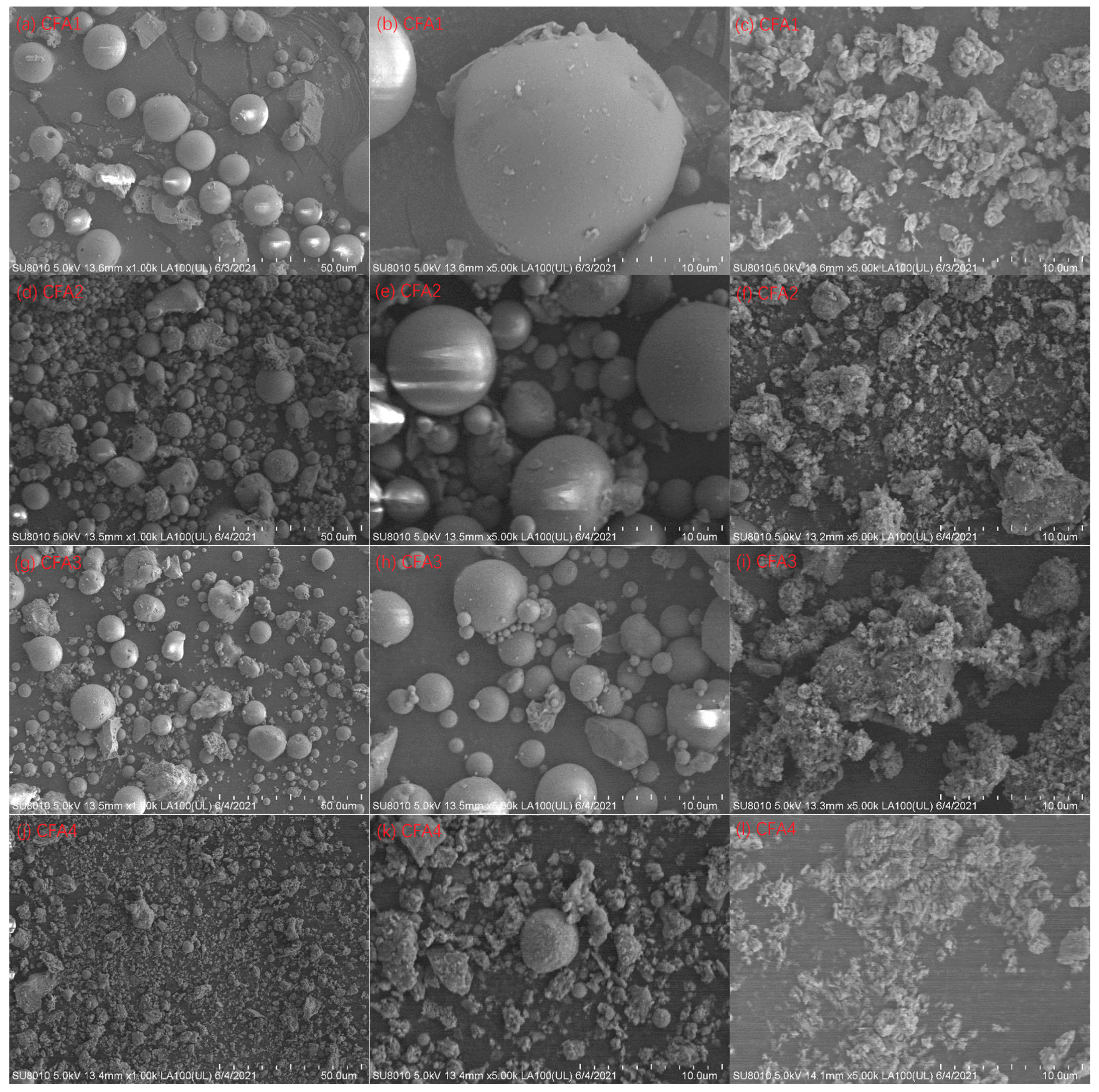
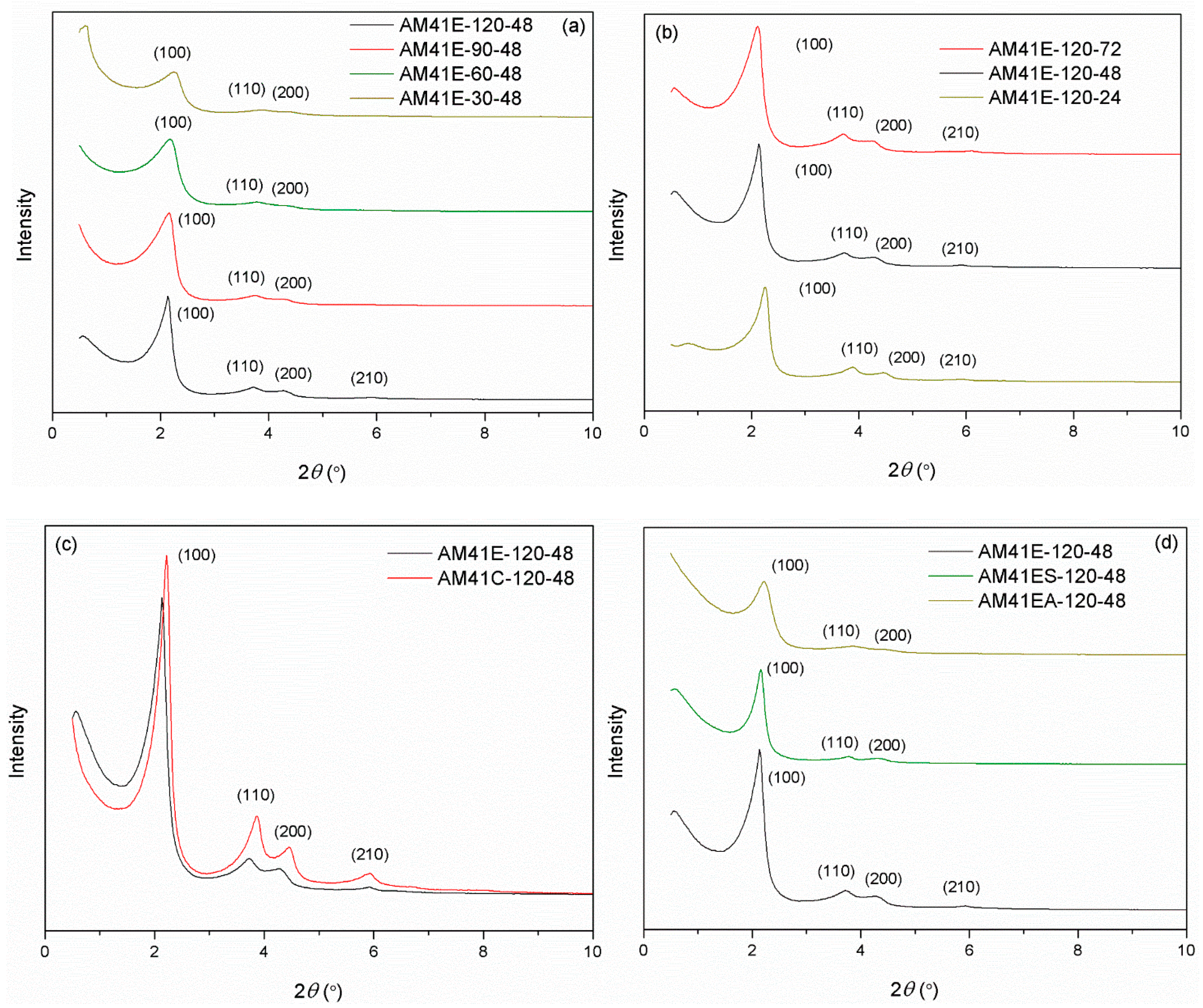


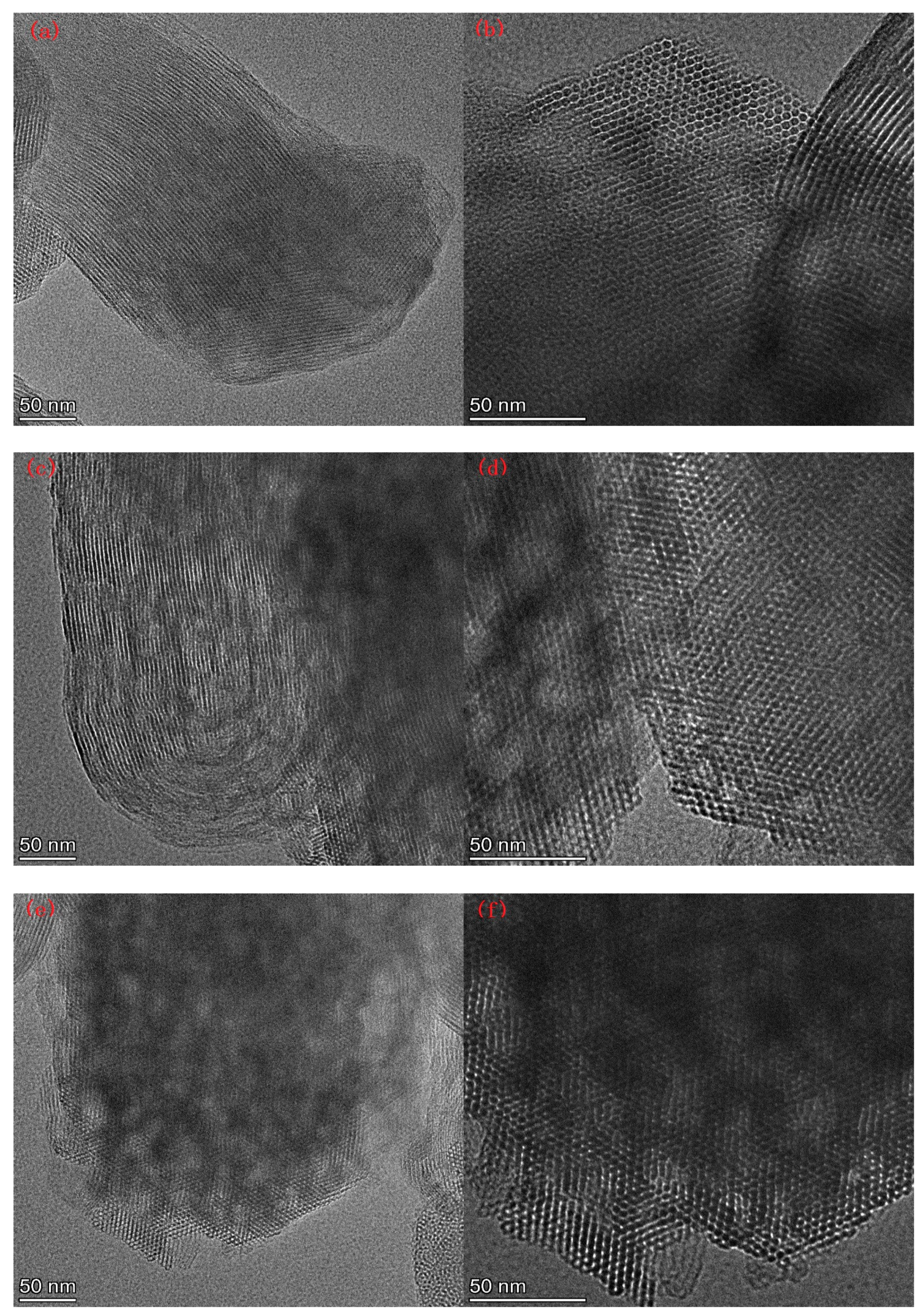

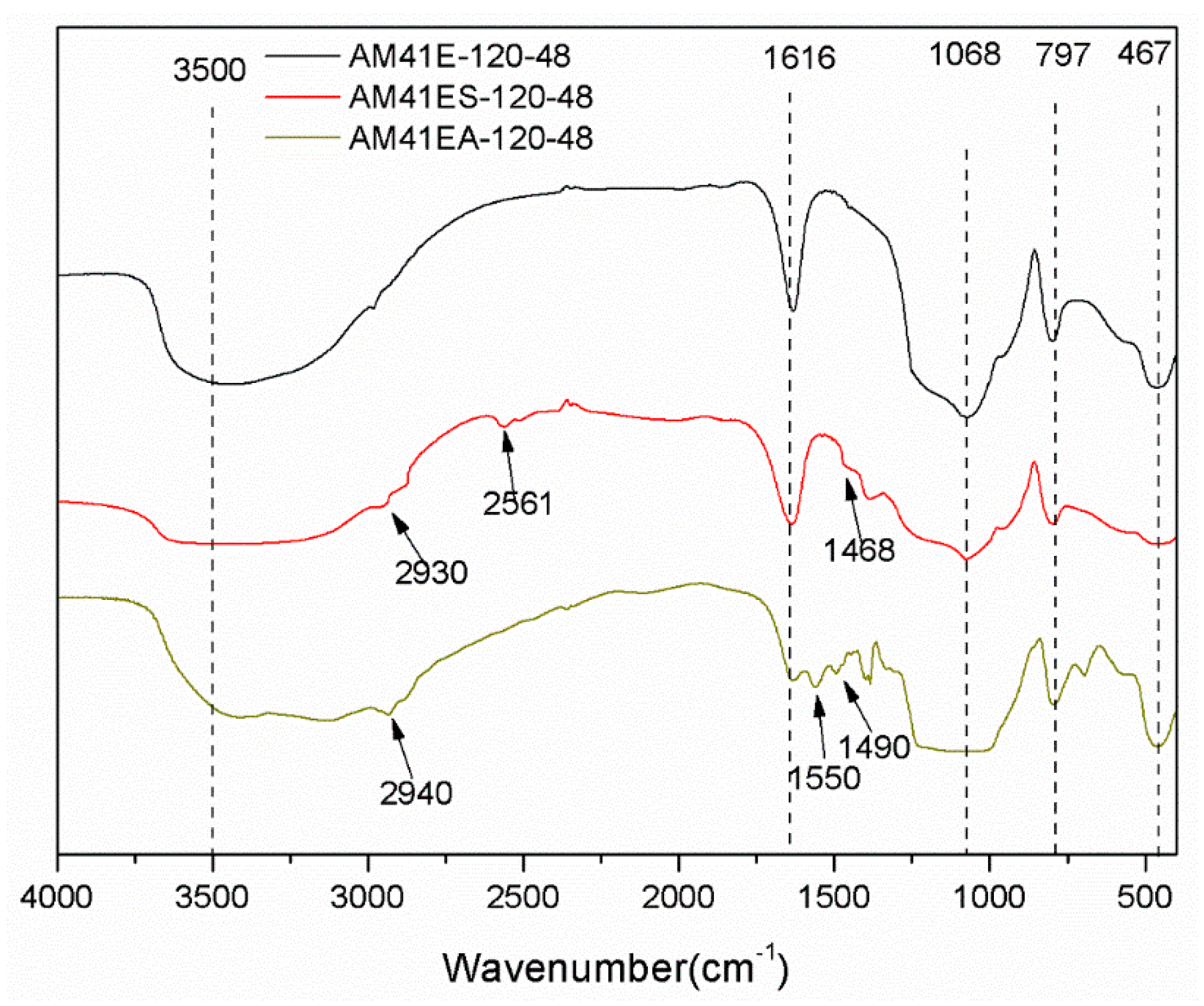
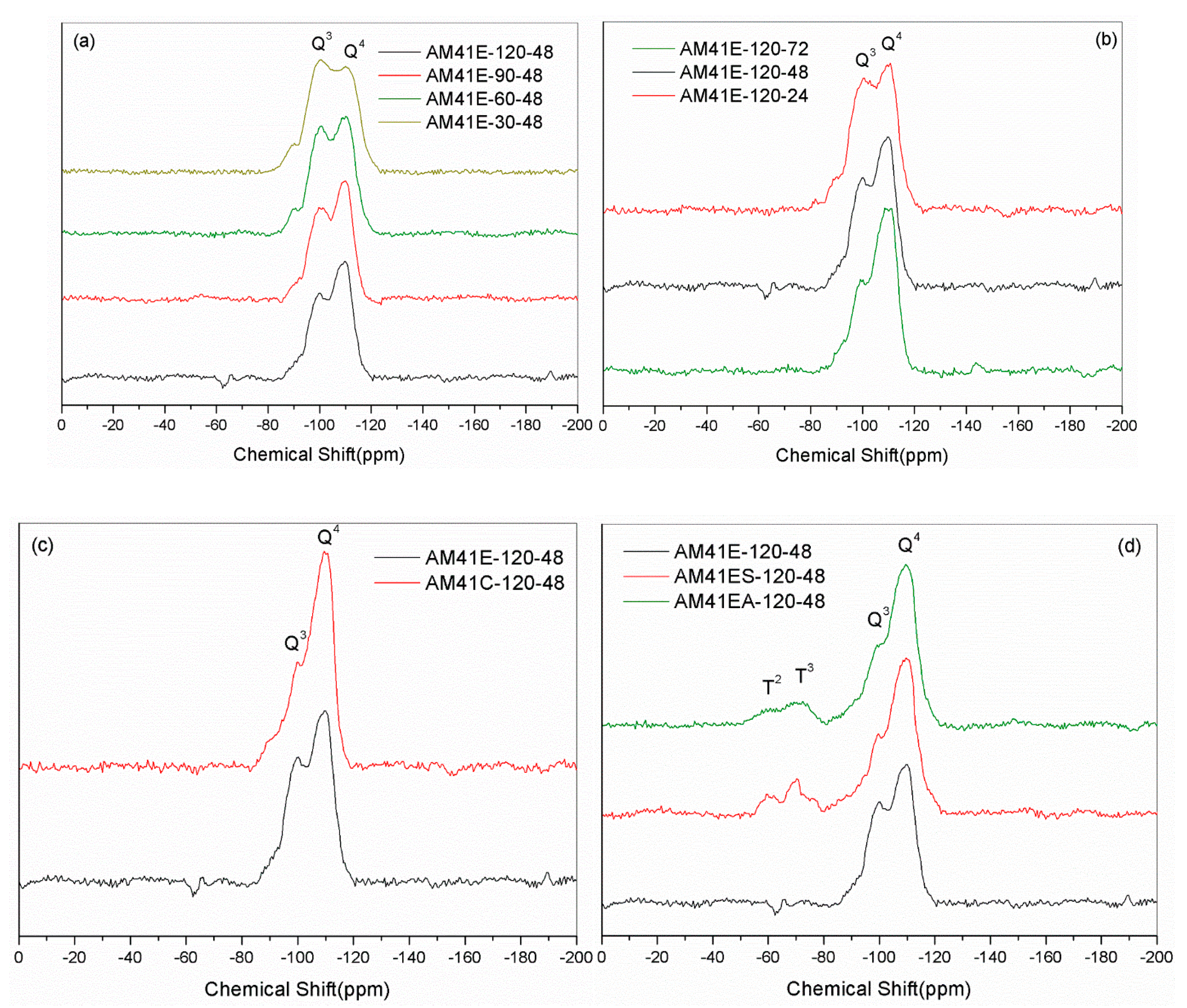
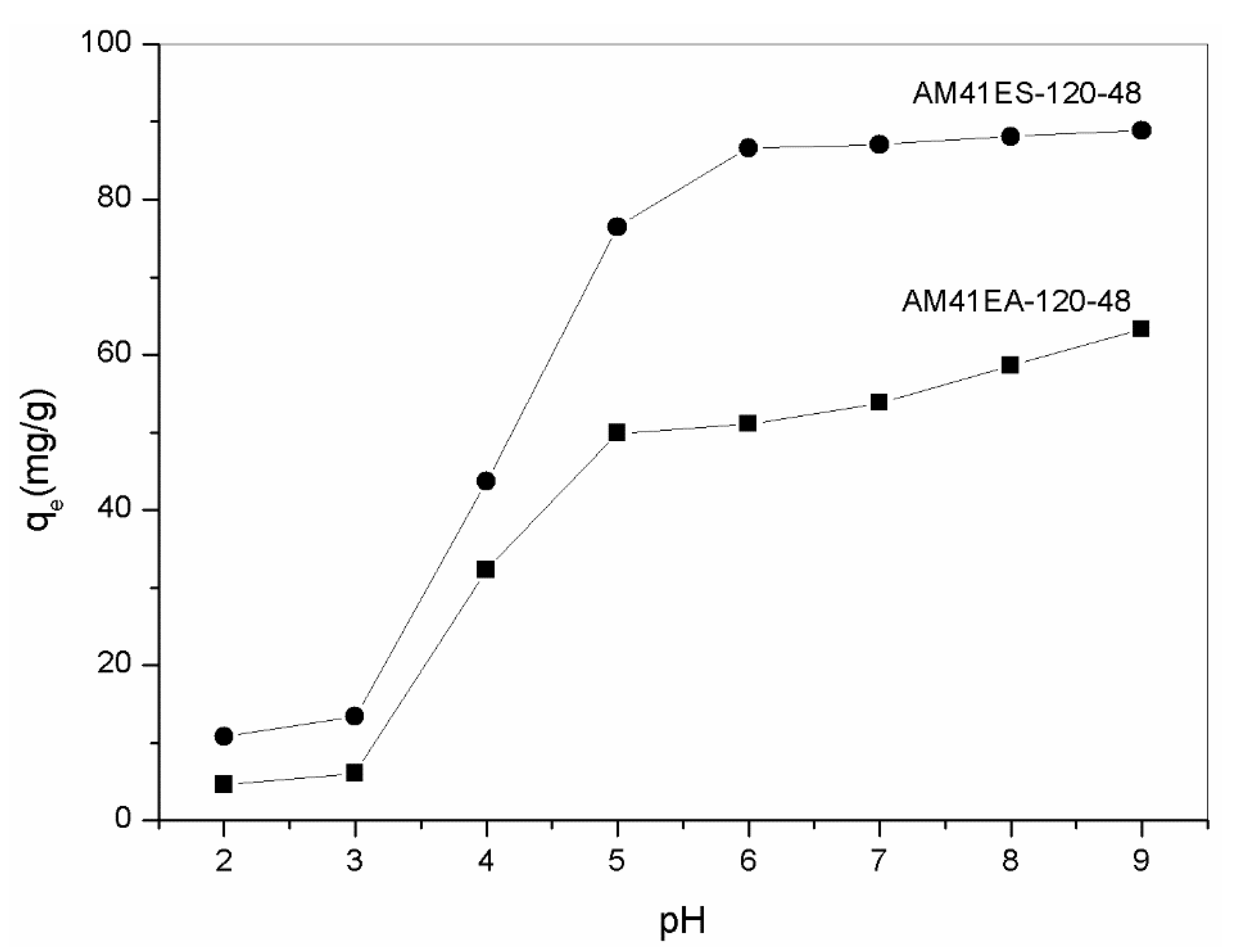
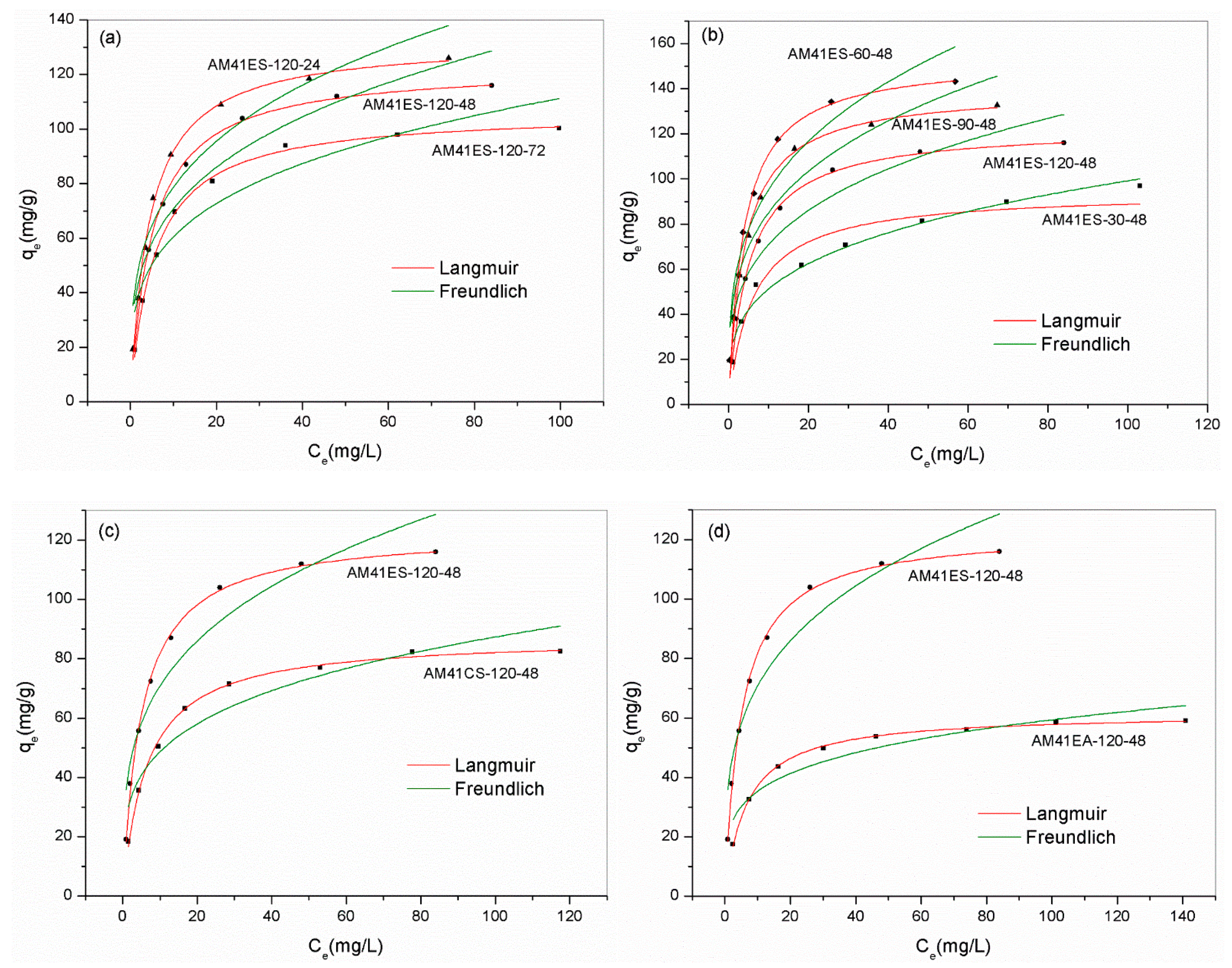
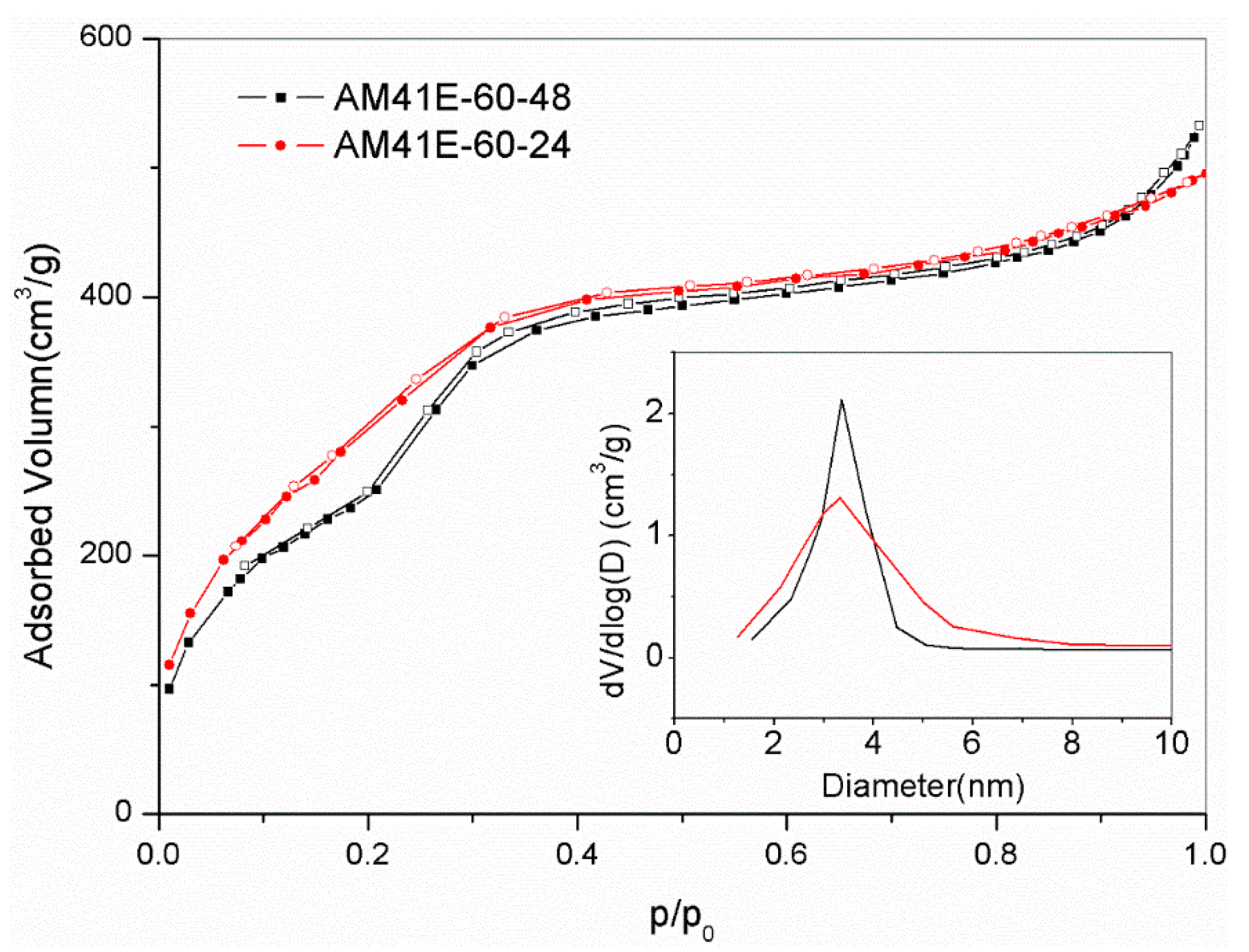

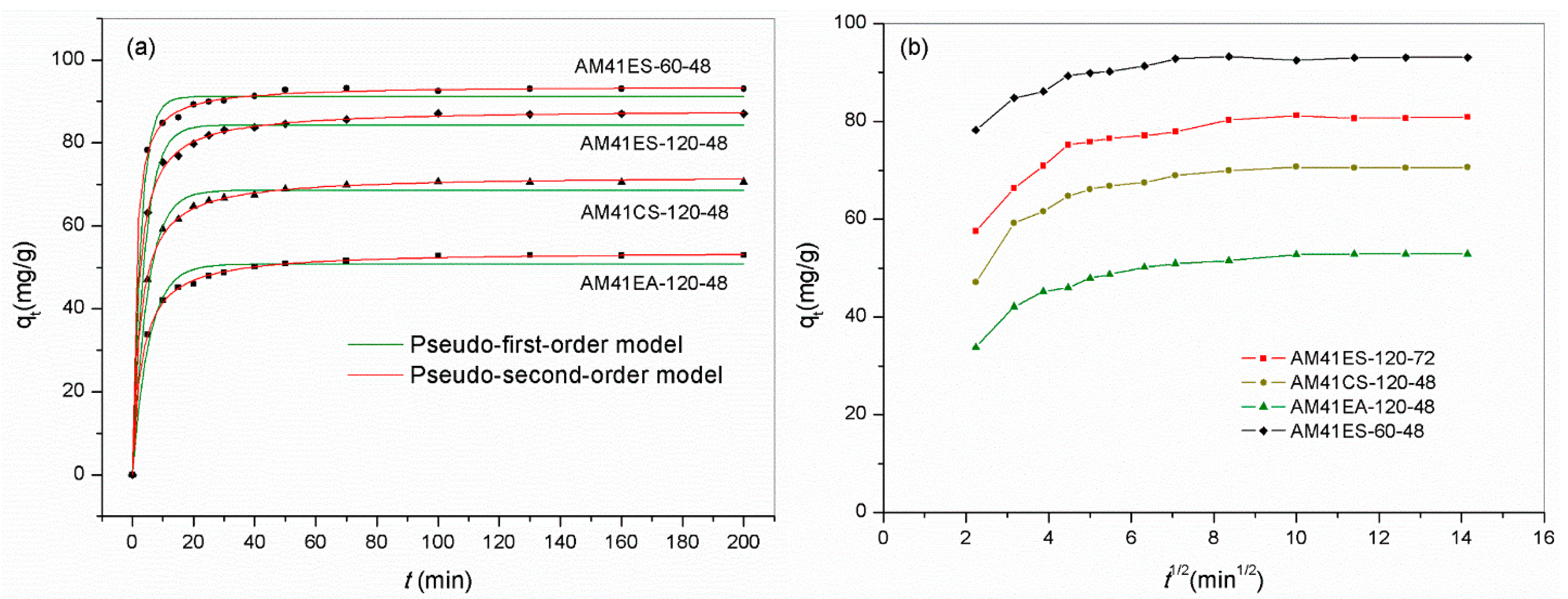
| Samples | Chemical Composition | Mineral Composition | ||||||||
|---|---|---|---|---|---|---|---|---|---|---|
| SiO2 | Al2O3 | Fe2O3 | CaO | K2O | MgO | Crystal Phase | Glass Phase | |||
| Quartz | Mullite | SiO2 | Al2O3 | |||||||
| CFA1 | 62.7 | 19.8 | 3.8 | 6.4 | 2.2 | 1.0 | 38.3 | 19.6 | 18.9 | 5.7 |
| CFA2 | 63.2 | 20.9 | 4.4 | 5.7 | 2.5 | 1.1 | 44.7 | 21.7 | 12.4 | 5.3 |
| CFA3 | 64.3 | 22.7 | 5.0 | 2.6 | 2.5 | 1.1 | 43.5 | 25.3 | 13.7 | 4.5 |
| CFA4 | 58.9 | 21.3 | 9.1 | 5.3 | 2.4 | 1.1 | 41.1 | 9.1 | 16.2 | 12.1 |
| CFA | Activation Methods and Parameters | Supernatant | Conversion (%) | ||||||
|---|---|---|---|---|---|---|---|---|---|
| Method | Temp (°C) | Time (h) | Na/ CFA | L/S | Si (mg/L) | Al (mg/L) | Si (%) | Al (%) | |
| CFA1 | Hydro | 100 | 3 | 0.52 | 4 | 9303 | 347 | 12.7 | 1.32 |
| 200 | 6153 | 260 | 8.4 | 0.99 | |||||
| Microwave Hydro | 100 | 1 | 11,281 | 632 | 15.4 | 3.21 | |||
| 100 | 3 | 15,603 | 825 | 21.3 | 4.19 | ||||
| Fusion | 550 | 1 | 1.25 | 8 | 7314 | 428 | 20.0 | 3.26 | |
| 650 | 9266 | 702 | 25.3 | 5.35 | |||||
| 750 | 9706 | 806 | 26.5 | 6.14 | |||||
| CFA2 | Hydro | 100 | 3 | 0.52 | 4 | 4351 | 341 | 5.9 | 1.24 |
| 200 | 8260 | 118 | 11.2 | 0.43 | |||||
| Fusion | 550 | 1 | 1.25 | 8 | 7426 | 373 | 20.1 | 2.71 | |
| 650 | 9145 | 579 | 24.8 | 4.21 | |||||
| 750 | 9919 | 968 | 26.9 | 7.04 | |||||
| CFA3 | Hydro | 100 | 3 | 0.52 | 4 | 5700 | 291 | 7.6 | 0.97 |
| 200 | 10,650 | 36 | 14.2 | 0.12 | |||||
| Fusion | 550 | 1 | 1.25 | 8 | 8038 | 380 | 21.4 | 2.53 | |
| 650 | 9375 | 575 | 25 | 3.83 | |||||
| 750 | 10,238 | 909 | 27.3 | 6.06 | |||||
| CFA4 | Hydro | 100 | 3 | 0.52 | 4 | 3644 | 449 | 5.3 | 1.59 |
| 200 | 6600 | 93 | 9.6 | 0.33 | |||||
| Fusion | 550 | 1 | 1.25 | 8 | 7697 | 199 | 22.4 | 1.41 | |
| 650 | 9453 | 377 | 27.5 | 2.67 | |||||
| 750 | 9900 | 542 | 28.8 | 3.84 | |||||
| Energy Consumption of the Alkaline Fusion of CFA1 and 4 | ||||||
|---|---|---|---|---|---|---|
| ||||||
| CFA1 | CFA4 | ||||
| PC ash | CFB ash | ||||
| 1000 | 1000 | ||||
| 0.92 | 0.92 | ||||
| 62.7 | 58.9 | ||||
| 19.8 | 21.3 | ||||
| Different Tfusion | |||||
| 550 | 650 | 750 | 550 | 650 | 750 | |
| ESi obtained at different Tfusion | |||||
| 20 | 25.3 | 26.5 | 22.4 | 27.5 | 28.8 | |
| EAl obtained at different Tfusion | |||||
| 3.26 | 5.35 | 6.14 | 1.41 | 2.67 | 3.84 | |
| ||||||
| mM41 obtained at different Tfusion | |||||
| 132 | 169 | 178 | 135 | 168 | 178 | |
| ||||||
| ||||||
| Effective heat: Qe (kJ) | 487,600 | 579,600 | 671,600 | 487,600 | 579,600 | 671,600 |
| ||||||
| Energy loss Q1 (kJ) | 14,400 | 14,400 | 14,400 | 14,400 | 14,400 | 14,400 |
| ||||||
| Energy loss Q2 (kJ) | 7200 | 7200 | 7200 | 7200 | 7200 | 7200 |
| ||||||
| Energy loss Q3 (kJ) | 32,400 | 32,400 | 32,400 | 32,400 | 32,400 | 32,400 |
| ||||||
| Energy loss Q4 (kJ) | 3600 | 3600 | 3600 | 3600 | 3600 | 3600 |
| ||||||
| Energy loss Q5 (kJ) | 7200 | 7200 | 7200 | 7200 | 7200 | 7200 |
| ||||||
| Energy loss Q6 (kJ) | 43,200 | 48,600 | 54,000 | 43,200 | 48,600 | 54,000 |
| ||||||
| Total energy consumption Qall (kJ) | 714,720 | 831,600 | 948,480 | 714,720 | 831,600 | 948,480 |
| ||||||
| Total energy loss Qloss (kJ) | 227,120 | 252,000 | 276,880 | 227,120 | 252,000 | 276,880 |
| ||||||
| ||||||
| Total efficiency f (%) | 68.2 | 69.7 | 70.8 | 68.2 | 69.7 | 70.8 |
| ||||||
| Energy consumption rate q (kJ/kg) | 5421 | 4914 | 5319 | 5297 | 4960 | 5334 |
| Reference | CFA | Activation Methods and Parameters | Supernatant | Conversion (%) | ||||||
|---|---|---|---|---|---|---|---|---|---|---|
| Si (wt.%) | Al (wt.%) | Temperature (°C) | Time (h) | Alkali/ CFA | Water/ CFA | Si (mg/L) | Al (mg/L) | Si (%) | Al (%) | |
| Izabela et al. [35] | 46–55 | 18–32 | 550 | 1 | 1.2 | 4 | 1400–2900 | 960–2300 | 7–10 | 5–12 |
| Halina et al. [43] | 66 | 16 | 5 | 10,000 | 367 | 33 | 4 | |||
| Chang et al. [44] | 56 | 31 | 5 | 2740 | 528 | 8 | 3 | |||
| Kumar et al. [31] | 67 | 19 | 4 | 11,000 | 380 | 18 | 2 | |||
| Sample | SXRD | N2 Isotherms | ||||
|---|---|---|---|---|---|---|
| d100, nm | a0, nm | SBET, m2/g | dBJH, nm | VPORE, cm3/g | W, nm | |
| AM41E-120-48 | 4.14 | 4.78 | 791 | 3.47 | 0.77 | 1.31 |
| AM41E-90-48 | 4.10 | 4.73 | 803 | 3.42 | 0.78 | 1.29 |
| AM41E-60-24 | - | - | 848 | 3.46 | 0.81 | 1.22 |
| AM41E-60-48 | 4.06 | 4.69 | 824 | 3.44 | 0.87 | 1.25 |
| AM41E-30-48 | 3.95 | 4.56 | 861 | 3.39 | 0.75 | 1.17 |
| AM41C-120-48 | 3.98 | 4.60 | 1055 | 3.24 | 0.96 | 1.36 |
| AM41E-120-24 | 4.02 | 4.64 | 831 | 3.38 | 0.73 | 1.26 |
| AM41E-120-72 | 4.17 | 4.82 | 788 | 3.49 | 0.76 | 1.33 |
| AM41ES-120-48 | 4.10 | 4.73 | 374 | 3.38 | 0.33 | - |
| AM41EA-120-48 | 3.98 | 4.60 | 261 | 3.21 | 0.21 | - |
| Sample | Q4, ppm | Q3, ppm | Area of Q4 | Area of Q3 | Q4/Q3 |
|---|---|---|---|---|---|
| AM41E-120-48 | −112 | −102 | 21,143 | 11,746 | 1.8 |
| AM41E-90-48 | −111 | −102 | 20,819 | 14,871 | 1.4 |
| AM41E-60-48 | −111 | −102 | 18,751 | 15,626 | 1.2 |
| AM41E-30-48 | −112 | −102 | 17,283 | 19,203 | 0.9 |
| AM41C-120-48 | −112 | −101 | 23,102 | 5635 | 4.1 |
| AM41E-120-24 | −112 | −102 | 19,885 | 15,296 | 1.3 |
| AM41E-120-72 | −112 | −101 | 21,963 | 6863 | 3.2 |
| AM41ES-120-48 | −111 | −102 | 18,726 | 4161 | 4.5 |
| AM41EA-120-48 | −112 | −102 | 18,931 | 4403 | 4.3 |
| Adsorbent | S | C | H | Si1 b | Si2 b | Al | O | Si2/Al c | S/Pb c |
|---|---|---|---|---|---|---|---|---|---|
| AM41ES-120-72 | 6.95 | 8.00 | 2.50 | 6.38 | 30.3 | 2.26 | 38.2 | 12.9 | 4.22 |
| AM41ES-120-48 | 8.10 | 9.16 | 2.77 | 6.97 | 28.4 | 2.15 | 35.8 | 12.8 | 4.26 |
| AM41ES-120-24 | 8.80 | 9.59 | 3.04 | 7.38 | 29.0 | 2.13 | 35.5 | 13.1 | 4.30 |
| AM41ES-90-48 | 9.32 | 10.99 | 3.42 | 8.31 | 27.4 | 2.10 | 33.7 | 12.8 | 4.32 |
| AM41ES-60-48 | 10.32 | 11.28 | 3.62 | 9.32 | 26.2 | 1.99 | 33.0 | 12.9 | 4.36 |
| AM41ES-30-48 | 7.03 | 8.16 | 2.56 | 5.86 | 30.1 | 2.17 | 37.8 | 13.4 | 4.42 |
| AM41CS-120-48 | 5.60 | 6.55 | 1.98 | 5.01 | 31.9 | 2.33 | 40.0 | 13.1 | 4.15 |
| AM41EA-120-48 a | 3.95 | 9.68 | 2.85 | 7.85 | 30.8 | 2.30 | 38.7 | 12.9 | 9.49 |
| Adsorbent (Temperature) | Langmuir | Freundlich | ||||
|---|---|---|---|---|---|---|
| qm, mg/g | b, L/mg | R2 | kF, mg/g | n | R2 | |
| AM41ES-120-72 (25) | 106.4 | 0.181 | 0.997 | 32.9 | 3.783 | 0.890 |
| AM41ES-120-48 (25) | 123.0 | 0.198 | 0.998 | 37.1 | 3.567 | 0.896 |
| AM41ES-120-24 (25) | 132.4 | 0.226 | 0.996 | 41.2 | 3.563 | 0.896 |
| AM41ES-90-48 (25) | 139.5 | 0.247 | 0.995 | 44.3 | 3.534 | 0.906 |
| AM41ES-60-48 (25) | 153.0 | 0.262 | 0.992 | 48.3 | 3.397 | 0.907 |
| AM41ES-60-48 (35) | 159.2 | 0.275 | 0.991 | 49.9 | 3.278 | 0.928 |
| AM41ES-60-48 (45) | 167.3 | 0.269 | 0.988 | 51.5 | 3.175 | 0.935 |
| AM41ES-30-48 (25) | 94.1 | 0.163 | 0.943 | 26.4 | 3.476 | 0.966 |
| AM41CS-120-48 (25) | 87.3 | 0.157 | 0.997 | 27.1 | 3.938 | 0.892 |
| AM41EA-120-48 (25) | 61.6 | 0.153 | 0.998 | 21.0 | 4.436 | 0.886 |
| Adsorbent | Pseudo-First-Order Kinetics | Pseudo-Second-Order Kinetics | ||
|---|---|---|---|---|
| k1, 1/min | R2 | k2, g/(mg·min) | R2 | |
| AM41ES-120-48 | 0.251 | 0.984 | 0.0059 | 0.999 |
| AM41CS-120-48 | 0.209 | 0.986 | 0.0056 | 0.999 |
| AM41EA-120-48 | 0.186 | 0.976 | 0.0063 | 0.999 |
| AM41ES-60-48 | 0.366 | 0.991 | 0.0103 | 0.999 |
| Adsorbent | Cycles | Time (h) | Eluent | Capacity Loss (%) | Reference |
|---|---|---|---|---|---|
| Thiol-functionalized MCM-41 | 3 | - | Concentrated HCl | 65 | [64] |
| Thiol-functionalized MCM-41 | 7 | 30 | 1 mol/L of HNO3 | 8 | [50] |
| Thiol-functionalized MCM-41 | 3 | 6 | 0.1 mol/L triethylenetetramine | 32 | [63] |
| Magnetic thiolated -chitosan composites | 5 | - | 0.1 mol/L HCl | 7 | [59] |
| AM41ES-60-48 | 3 | 8 | 0.1 mol/L HCl | 12 | This study |
| Adsorbent | Capacity (mg/g) | Reference |
|---|---|---|
| Thiol-functionalized MCM-41 | 110.6 | [50] |
| Hollow SiO2 microspheres with thiol-rich surfaces | 125.3 | [12] |
| Thiol-functionalized silica | 117.5 | [58] |
| Thiol-functionalized magnetic mesoporous silica | 91.5 | [60] |
| Thiol-functionalized large pore diameter MCM-41 | 88.0 | [9] |
| Post-NH2-extracted MCM-41 | 64.21 | [48] |
| Magnetically modified mesoporous nanoparticles | 238.1 | [65] |
| Chitosan-functionalized MCM-41-A | 90.9 | [2] |
| AM41ES-60-48 | 153.0 | This study |
| Temp (°C) | Time (h) | Detemplation | Al-MCM-41 | Ligand | Adsorbent |
|---|---|---|---|---|---|
| 30 | 48 | Extraction | AM41E-30-48 | MPTMS | AM41ES-30-48 |
| 60 | 24 | Extraction | AM41E-60-24 | MPTMS | AM41ES-60-24 |
| 60 | 48 | Extraction | AM41E-60-48 | MPTMS | AM41ES-60-48 |
| 90 | 48 | Extraction | AM41E-90-48 | MPTMS | AM41ES-90-48 |
| 120 | 24 | Extraction | AM41E-120-24 | MPTMS | AM41ES-120-24 |
| 120 | 48 | Extraction | AM41E-120-48 | MPTMS | AM41ES-120-48 |
| 120 | 48 | Extraction | AM41E-120-48 | APTMS | AM41EA-120-48 |
| 120 | 48 | Calcination | AM41C-120-48 | MPTMS | AM41CS-120-48 |
| 120 | 72 | Extraction | AM41E-120-72 | MPTMS | AM41ES-120-72 |
Publisher’s Note: MDPI stays neutral with regard to jurisdictional claims in published maps and institutional affiliations. |
© 2021 by the authors. Licensee MDPI, Basel, Switzerland. This article is an open access article distributed under the terms and conditions of the Creative Commons Attribution (CC BY) license (https://creativecommons.org/licenses/by/4.0/).
Share and Cite
Zhang, X.; Du, T.; Jia, H. Efficient Activation of Coal Fly Ash for Silica and Alumina Leaches and the Dependence of Pb(II) Removal Capacity on the Crystallization Conditions of Al-MCM-41. Int. J. Mol. Sci. 2021, 22, 6540. https://doi.org/10.3390/ijms22126540
Zhang X, Du T, Jia H. Efficient Activation of Coal Fly Ash for Silica and Alumina Leaches and the Dependence of Pb(II) Removal Capacity on the Crystallization Conditions of Al-MCM-41. International Journal of Molecular Sciences. 2021; 22(12):6540. https://doi.org/10.3390/ijms22126540
Chicago/Turabian StyleZhang, Xu, Tao Du, and He Jia. 2021. "Efficient Activation of Coal Fly Ash for Silica and Alumina Leaches and the Dependence of Pb(II) Removal Capacity on the Crystallization Conditions of Al-MCM-41" International Journal of Molecular Sciences 22, no. 12: 6540. https://doi.org/10.3390/ijms22126540





